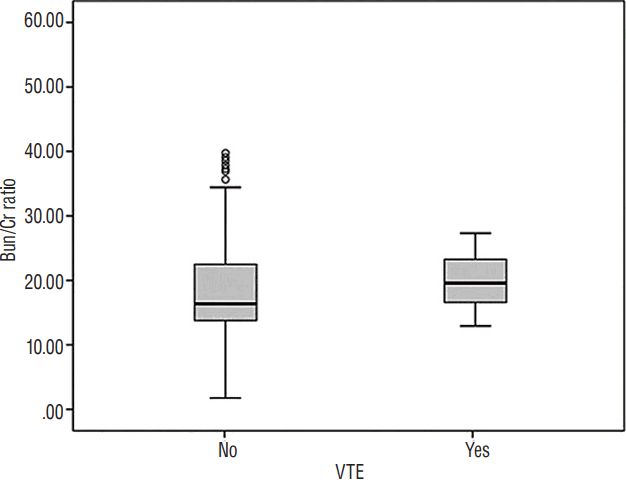1. Agrawal M, Swartz R. Acute renal failure. Am Fam Physician. 61:2077–2088. 2000.
2. Anderson FA Jr, Spencer FA. Risk factors for venous thromboembolism. Circulation. 107(23 Suppl 1):I9–I16. 2003.

3. Ansell JE. Air travel and venous thromboembolism--is the evidence in? N Engl J Med. 345:828–829. 2001.

4. Bembenek J, Karlinski M, Kobayashi A, Czlonkowska A. Early stroke-related deep venous thrombosis: risk factors and influence on outcome. J Thromb Thrombolysis. 32:96–102. 2011.

5. Bennett JA, Thomas V, Riegel B. Unrecognized chronic dehydration in older adults: examining prevalence rate and risk factors. J Gerontol Nurs. 30:22–28. quiz 52–53. 2004.

6. Bhalla A, Sankaralingam S, Dundas R, Swaminathan R, Wolfe CD, Rudd AG. Influence of raised plasma osmolality on clinical outcome after acute stroke. Stroke. 31:2043–2048. 2000.

7. Bhatia K, Mohanty S, Tripathi BK, Gupta B, Mittal MK. Predictors of early neurological deterioration in patients with acute ischaemic stroke with special reference to blood urea nitrogen (BUN)/creatinine ratio & urine specific gravity. Indian J Med Res. 141:299–307. 2015.

8. Bounds JV, Wiebers DO, Whisnant JP, Okazaki H. Mechanisms and timing of deaths from cerebral infarction. Stroke. 12:474–477. 1981.

9. Broderick JP, Palesch YY, Demchuk AM, Yeatts SD, Khatri P, Hill MD, et al. Endovascular therapy after intravenous t-PA versus t-PA alone for stroke. N Engl J Med. 368:893–903. 2013.

10. CLOTS Trials Collaboration. Dennis M, Sandercock PA, Reid J, Graham C, Murray G, et al. Effectiveness of thigh-length graduated compression stockings to reduce the risk of deep vein thrombosis after stroke (CLOTS trial 1): a multicentre, randomised controlled trial. Lancet. 373:1958–1965. 2009.

11. Goldman RD, Friedman JN, Parkin PC. Validation of the clinical dehydration scale for children with acute gastroenteritis. Pediatrics. 122:545–549. 2008.

12. González-Alonso J, Calbet JA, Nielsen B. Muscle blood flow is reduced with dehydration during prolonged exercise in humans. J Physiol. 513(Pt 3):895–905. 1998.

13. Harvey RL. Prevention of venous thromboembolism after stroke. Top Stroke Rehabil. 10:61–69. 2003.

14. Hull RD. Revisiting the past strengthens the present: an evidence-based medicine approach for the diagnosis of deep venous thrombosis. Ann Intern Med. 142:583–585. 2005.

15. Jauch EC, Saver JL, Adams HP Jr, Bruno A, Connors JJ, Demaerschalk BM, et al. Guidelines for the early management of patients with acute ischemic stroke: a guideline for healthcare professionals from the American Heart Association/American Stroke Association. Stroke. 44:870–947. 2013.

16. Kelly J, Rudd A, Lewis RR, Coshall C, Moody A, Hunt BJ. Venous thromboembolism after acute ischemic stroke: a prospective study using magnetic resonance direct thrombus imaging. Stroke. 35:2320–2325. 2004.
17. Kelly J, Rudd A, Lewis RR, Coshall C, Parmar K, Moody A, et al. Screening for proximal deep vein thrombosis after acute ischemic stroke: a prospective study using clinical factors and plasma D-dimers. J Thromb Haemost. 2:1321–1326. 2004.

18. Landi G, D’Angelo A, Boccardi E, Candelise L, Mannucci PM, Morabito A, et al. Venous thromboembolism in acute stroke. Prognostic importance of hypercoagulability. Arch Neurol. 49:279–283. 1992.
19. Leibovitz A, Baumoehl Y, Lubart E, Yaina A, Platinovitz N, Segal R. Dehydration among long-term care elderly patients with oropharyngeal dysphagia. Gerontology. 53:179–183. 2007.

20. Liu CH, Lin SC, Lin JR, Yang JT, Chang YJ, Chang CH, et al. Dehydration is an independent predictor of discharge outcome and admission cost in acute ischaemic stroke. Eur J Neurol. 21:1184–1191. 2014.

21. Marik PE, Andrews L, Maini B. The incidence of deep venous thrombosis in ICU patients. Chest. 111:661–664. 1997.

22. Noel P, Gregoire F, Capon A, Lehert P. Atrial fibrillation as a risk factor for deep venous thrombosis and pulmonary emboli in stroke patients. Stroke. 22:760–762. 1991.

23. O’Neill PA, Davies I, Fullerton KJ, Bennett D. Fluid balance in elderly patients following acute stroke. Age Ageing. 21:280–285. 1992.

24. Oczkowski WJ, Ginsberg JS, Shin A, Panju A. Venous thromboembolism in patients undergoing rehabilitation for stroke. Arch Phys Med Rehabil. 73:712–716. 1992.
25. Pottier P, Hardouin JB, Lejeune S, Jolliet P, Gillet B, Planchon B. Immobilization and the risk of venous thromboembolism. A meta-analysis on epidemiological studies. Thromb Res. 124:468–476. 2009.

26. Riccardi A, Chiarbonello B, Minuto P, Guiddo G, Corti L, Lerza R. Identification of the hydration state in emergency patients: correlation between caval index and BUN/creatinine ratio. Eur Rev Med Pharmacol Sci. 17:1800–1803. 2013.
27. Rønning OM, Guldvog B. Stroke unit versus general medical wards, II: neurological deficits and activities of daily living: a quasi-randomized controlled trial. Stroke. 29:586–590. 1998.

28. Rowat A, Graham C, Dennis M. Dehydration in hospital-admitted stroke patients: detection, frequency, and association. Stroke. 43:857–859. 2012.
29. Schrock JW, Glasenapp M, Drogell K. Elevated blood urea nitrogen/creatinine ratio is associated with poor outcome in patients with ischemic stroke. Clin Neurol Neurosurg. 114:881–884. 2012.

30. Skaf E, Stein PD, Beemath A, Sanchez J, Bustamante MA, Olson RE. Venous thromboembolism in patients with ischemic and hemorrhagic stroke. Am J Cardiol. 96:1731–1733. 2005.

31. Steiner MJ, DeWalt DA, Byerley JS. Is this child dehydrated? JAMA. 291:2746–2754. 2004.

32. Sulter G, De Keyser J. From stroke unit care to stroke care unit. J Neurol Sci. 162:1–5. 1999.

33. Turpie AG, Levine MN, Hirsh J, Carter CJ, Jay RM, Powers PJ, et al. Double-blind randomised trial of Org 10172 low-molecular-weight heparinoid in prevention of deep-vein thrombosis in thrombotic stroke. Lancet. 1:523–526. 1987.

34. Vega RM, Avner JR. A prospective study of the usefulness of clinical and laboratory parameters for predicting percentage of dehydration in children. Pediatr Emerg Care. 13:179–182. 1997.

35. Virchow R. Thrombose und embolie. Gefässentzündung und septische infektion. Virchow R, editor. Gesammelte abhandlungen zur wissenschaftlichen medicin. Frankfurt: Verlag von Meidinger Sohn & Comp;1856. p. 219–732.
36. White RH, Zhou H, Romano PS. Incidence of idiopathic deep venous thrombosis and secondary thromboembolism among ethnic groups in California. Ann Intern Med. 128:737–740. 1998.

37. Yilmaz K, Karaböcüoglu M, Citak A, Uzel N. Evaluation of laboratory tests in dehydrated children with acute gastroenteritis. J Paediatr Child Health. 38:226–228. 2002.






 PDF
PDF Citation
Citation Print
Print


 XML Download
XML Download